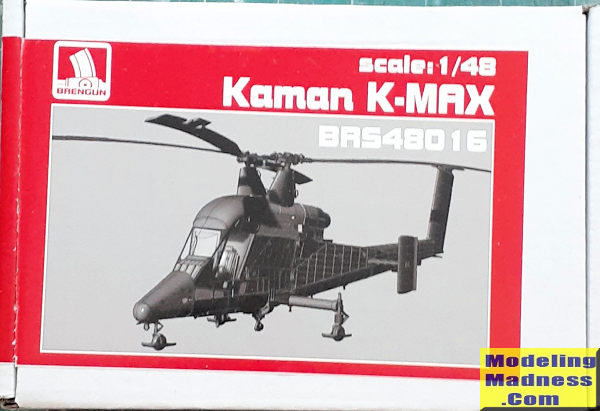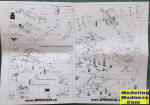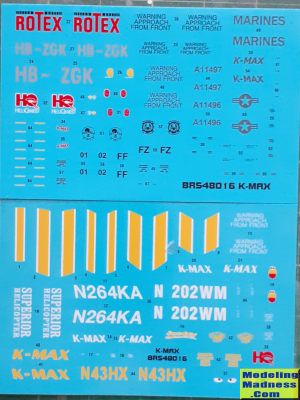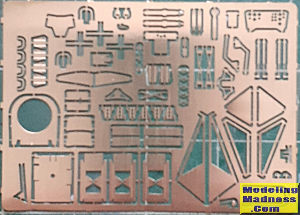
| KIT #: | 48016 |
| PRICE: | $100.00 |
| DECALS: | Five options |
| REVIEWER: | John Summerford |
| NOTES: | Resin, photo-etch, and vacuform kit. |

| HISTORY |
The Kaman K-MAX can trace its history to Anton Flettner’s WWII design of the Flettner Fl 282 Kolibri (Hummingbird) produced for the German military.
After the war, Flettner moved to the US as one of the “Paper Clip” émigré’s. He continued his work with intermesh rotors with his own company, the Flettner Aircraft Corporation, and obtained military research contracts, but no sustainable production contracts. He became the chief designer of Kaman Aircraft.
Kaman Aircraft produced the HH-43 Huskie helicopter for all branches of the military and they saw service in Viet Nam. That helicopter was powered by the Lycoming T53-L-11A turboshaft engine, providing 825 SHP (615 kW) de-rated from 1,150 SHP (858 kW)
The K-MAX was derived form the Huskie and uses an improved Honeywell T53-17A-1 turboshaft engine. It produces 1,350 SHP, (1,010 kW) derated to 1,080 SHP. (805 kW) The transmission has the same layout and is strengthened in order to absorb the increased power.
The biggest advantage of the intermeshing rotor system is that each rotor cancels the torque of the other, eliminating the need for a tail rotor. That means that all of the power generated by the power plant is directed to lift. At sea level, the K-MAX can sling a 6,000 lb. (2,722 kg) load and 4,313 lb. (1,956 kg) at 15,000 Ft. (4,572 m)
| THE KIT |
 Brengun
previously released a 72nd scale
kit of the K-MAX. This kit has more detail than its predecessor. A compact
corrugated shipping box holds a single bag of gray resin and clear-vac parts.
The decals, photo-etc
Brengun
previously released a 72nd scale
kit of the K-MAX. This kit has more detail than its predecessor. A compact
corrugated shipping box holds a single bag of gray resin and clear-vac parts.
The decals, photo-etc h fret, and acetate instrument faces are in another bag.
All of the parts are crisply molded. The parts count is 28 resin, 72 photo-etch,
and three clear-vac. Some of the photo-etch parts are dedicated to the military
version of the kit.
h fret, and acetate instrument faces are in another bag.
All of the parts are crisply molded. The parts count is 28 resin, 72 photo-etch,
and three clear-vac. Some of the photo-etch parts are dedicated to the military
version of the kit.
One sheet of paper has a
parts map and assembly sequence and another sheet has a brief military history
plus paint and decal diagrams. Assembly is broken down into 14 steps. A nice
touch is a  call-out for a 30-gram weight installed behind the cockpit to prevent
tail sitting. (It’s possible to hollow out the nose piece and put some weight
there.)
call-out for a 30-gram weight installed behind the cockpit to prevent
tail sitting. (It’s possible to hollow out the nose piece and put some weight
there.)
The first painting option is an all-gray US Marine ship based in Afghanistan during 2012 while the rest are civilian operators whose web sites can be found.
| CONCLUSIONS |
Yours truly was a ground crew member for a summer on a ship operated by one of the civilian companies fighting forest fires. When I saw this kit, I ignored the price and snapped it up. Many of the photo-etch pieces are “fiddly”, so this is a time-consuming build. Given the surface detail, masking for some of the paint schemes is a challenge.
Helicopter fans and those who like unusual subjects should enjoy having one of these on their shelf. If one has enough room, the rotors need to be displayed overlapping instead of parallel.A
| REFERENCES |
https://www.youtube.com/watch?v=yHcrvO5ZkNI&ab_channel=TechInsider
April 2022
Copyright ModelingMadness.com. All rights reserved. No reproduction in part or
in whole without express permission.
If you would like your product reviewed fairly and fairly quickly, please
contact
the editor or see other details in the
Note to
Contributors.